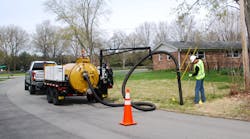By now, most people in the country have heard about the energy boom that has made North Dakota the third largest oil producing state. Currently, the state is taking advantage of another abundant resource and is building pipelines to help send it across the country.
According to the Department of Energy, the country’s stockpile of natural gas has increased over the years as demand has been lean, especially in the industrial sector. The 2011 winter was warm, which helped to decrease use and contribute to the increased supply. Many states would spend millions to access natural gas, but those states that already pump oil also can produce natural gas in many cases.
Williston Basin Interstate Pipeline, a subsidiary of MDU Resources Group Inc., Bismarck, N.D., provides the network through which energy supplies are stored and delivered. This sector built, owns and operates more than 3,700 miles of transmission and gathering pipelines along with three natural gas storage areas. WBIP operates 33 compressor stations in Montana, North Dakota, South Dakota, and Wyoming to move natural gas through the pipelines.On March 12, Williston Basin Interstate Pipeline began construction of the Stateline Pipeline project 10 miles northwest of Williston, near the heart of the Bakken Formation. WBIP began with research on the ground conditions and selected a route that would be feasible to build the pipeline from a gas processing plant to a connection point 12 miles away.
Route selection process
Steve Kelly, pipeline engineer on this project, said a team worked to select and adjust routes. “We looked at a pipeline route depending on ground conditions, found a general area where we want to install the pipeline, sent our surveyors to stake a line, determined if the route has any problems, and adjusted the route. We look for rock piles, trees, creeks, and other growths that we want to avoid on the ground,” he said.
Workers performed much preliminary work before construction began. As with most pipeline construction, the pipeline routes can cross private land, including farms, ranches and homes, and the owner must buy necessary easements from landowners before work begins.
“The pipes will be installed on other people’s property, and we have to work with landowners to get an agreement to construct on their properties,” said Tim Rasmussen, spokesperson for MDU Resources.
The process to obtain federal authority requires up to a year on average. “As a federally regulated pipeline company, we needed to obtain federal approval to build the pipeline. The government provides environmental and operational guidelines that we must follow during construction, and they provide project approval before construction starts,” said Rasmussen.
The company hired Tomahawk Pipeline Construction, Sheridan, Wyo., as the general contractor. Kelly said WBIP selected the contractor based on its ability and experience with pipeline construction. WBIP bought 16-inch steel pipelines from Ipsco, a pipeline manufacturer that delivered them to the site.
After approval of the right of way on private land, Kelly said his crew cleared the pipeline route using graders and dozers to removed rocks, trees and topsoil.
“We dug into the ground about five to six feet deep to place the pipelines underground because we needed four feet of cover over the pipeline. We looked for any rock and other obstructions to be removed. We want a smooth, flat surface in the trench to support the pipeline in one continuous connection,” said Kelly.
The pipeline route is generally straight with a few bends. The open trench is 30 inches wide with pipeline segments hauled in and placed along the route. As excavation continues along the 12 miles, welders begin to join segments as they work along the right of way.
X-ray all welds
“Once segments are welded, we X-ray the welds and then coat them for corrosion protection. The U.S. DOT requires a certain percentage of welds to undergo X-ray that confirms their connections on any underground pipeline project. I’m performing X-rays on 100 percent of the welds on the Stateline Pipeline job,” said Kelly.
“With welding completed, the pipelines are lowered to the bottom of the trench and our requirements are we can’t have pipe lengths longer than 15 feet unsupported. Usually, that’s not an issue unless an area is difficult to excavate.
“When we’re done installing the pipeline, we backfill the original soil and compact the surface. Then we perform a hydro test to make sure the pipeline will hold the necessary maximum operating pressure. We’ll reclaim the right of way back to its original state, and seed it to it,” said Kelly.
Third-party inspection
Kelly hired a third-party inspection company to inspect every process during construction: welding, boring, working on the right of way, land reclamation, and clean up.
“Inspectors have to watch every step as the federal government requires. The company’s pipeline integrity group also inspects and monitors the pipeline after completion and performs a direct assessment every seven years in which we select random areas along the pipeline and dig up the pipeline,” said Kelly.
The project will be complete in June to connect the natural gas processing plant to a tie-in point on another major artery pipeline that sends the gas to locations across the country. At the processing plant, water and other materials are removed from the natural gas, which becomes the useable product that travels through pipelines.
WBIP specializes in construction and operation of natural gas transmission pipelines with capacities from the Bakken Formation to mid-continent markets.
MDU Resources Group began in the 1920s as Montana Dakota Utilities Company, a publicly held utility company with initial operations near Baker, Mont. Over the years, the company consolidated its many operations into three distinct divisions under MDU Resource Group, the parent company. Independent state regulatory agencies monitor company operations in its utility service territory. n




